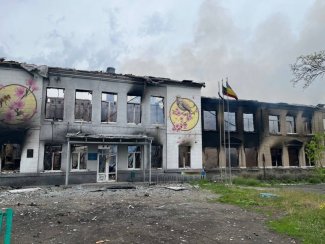Ukraine in the face of a demographic catastrophe

The Russian invasion of Ukraine has aggravated the country’s already extremely difficult demographic situation, creating the prospect of a demographic catastrophe. Over the course of its three decades of independence, Ukraine has experienced a deepening population loss due to negative birth rates and high migration dynamics. Although Ukraine had a population of 51.5 million after gaining independence, in 2019 its estimated population size was a mere 37 million. The ongoing war has resulted in a large (although undisclosed) number of both military (mostly men in their prime) and civilian casualties, and has triggered a wave of refugees whose prospects of returning to their former places of residence are unclear. The invasion has worsened the physical and mental health of Ukrainian citizens and contributed to further negative trends in the younger generations’ decisions to procreate, out of uncertainty regarding the economic situation in the near to mid-term future.
Although the forecasts regarding Ukraine’s population after the end of the hostilities differ, all of them are extremely pessimistic. They estimate the future size of Ukraine’s population at between 24 million and 35 million individuals, and argue that by 2030 Ukrainian society may likely be one of Europe’s oldest, with a high proportion of individuals suffering from multiple illnesses, disabilities, post-traumatic stress disorder (PTSD) and depression. As a consequence, while Ukraine was one of Europe’s most populous countries 30 years ago, it is now facing a demographic gap, the magnitude of which will hamper its dynamic development and post-war reconstruction.
Three decades of population decline
Analysing Ukraine’s demographic situation, especially in the last decade, has not been easy due to the lack of official and comprehensive data on the subject, and to discrepancies in the information published by various institutions, both Ukrainian and international. During the period of Ukraine’s independence only one census was carried out over 20 years ago (in 2001). According to this census, at that time the country was inhabited by 48.5 million individuals (whereas the previous census carried out in 1989 had estimated this figure at 51.5 million individuals). Although plans were made to carry out another census in 2013, successive governments postponed it (citing various reasons including a lack of funds): first until 2016, then to 2020, and next to 2023 (at present the ongoing war poses the greatest obstacle to organising a census).
In 2019, that is, when Volodymyr Zelensky was already president, a government task force compiled an electronic estimate (the so-called Dubilet census) using data from various sources, including mobile telephone operators. It estimated that Ukraine’s population stood at 37.3 million (excluding Crimea and those parts of Donetsk and Luhansk oblasts which Kyiv does not control). Around the same time, the State Statistics Service of Ukraine (Derzhstat) published data which indicated that the number of individuals inhabiting Ukraine (excluding Crimea, but including Donetsk and Luhansk oblasts) was 41.9 million.[1] Although many demography experts criticised Dubilet’s census for its methodology, at the same time numerous commentators considered it more reliable than traditional censuses because it recorded the number of actual (rather than officially registered) inhabitants of specific regions and cities. Moreover, it was not hampered by the frequent problem of people refusing to admit the census takers into their homes. Despite this, the UN reprimanded Ukraine and called for a standard census of the kind which, according to international recommendations, should on average be conducted every 10 years.[2]
Back in 2021, before the current stage of the invasion, Ukraine’s demographic situation was so difficult that the UN recognised Ukraine as one of the countries most affected by the quick pace of population decline. The main reasons for Ukraine’s population decline after 1990 were many years of negative birth rates (the number of deaths significantly exceeding the number of births) and the very large scale of labour migration. In 1995, Ukraine’s population growth rate (the difference between the number of births and the number of deaths in proportion to the total population count) was -5.8%, in 2000 -7.6%, in 2005 -7.6%, in 2010 -4.4%, in 2015 -4.2%, and -6.6% in 2019 (data compiled by the State Statistics Service of Ukraine).[3] In 2021, Ukraine’s population fell by 442,000 individuals,[4] and in January 2022 there were merely 39 births per 100 deaths.
Chart 1. Ukraine’s population change dynamic

Source: data compiled by the State Statistics Service of Ukraine, ukrstat.gov.ua.
The decline in Ukraine’s population has been aggravated for years by labour migration, which has frequently become permanent emigration. Following the collapse of the USSR, Ukrainians mainly migrated to seek employment in Russia, and post-2010 in Russia and Poland, as these two countries had relatively liberal migration policies. According to the Russian Federal Migration Service, in 2015 around 2.6 million Ukrainians went to work in Russia.[5] In subsequent years, the proportion changed in Poland’s favour,[6] while the economic migration of Ukrainians to Russia stopped in 2022. A major increase in the number of Ukrainians seeking employment in the EU member states, in particular Poland, has been recorded since 2014. This trend was bolstered by both the Russian invasion and Ukraine’s declining economic situation, as well as simplified procedures for entering the Schengen zone (a visa-free regime has been in place since 2017). In formal terms, although this method of travel does not entitle Ukrainians to take up a job in these countries, it facilitates their travel and the possible further legalisation of their residence there. Also, educational migration has shown a steady upward trend.
Although a portion of this migration was seasonal and circular, over time an increasing proportion of migrants chose to settle in their host countries. Even though it is difficult to make comprehensive estimates due to the absence of EU-wide statistical data on migrants, the number of residence cards issued to Ukrainian citizens by EU member states can be considered an indicator of the dynamics of Ukrainian settlement activity in the EU and of the geographical distribution of their new places of residence. According to Eurostat data, as of the end of 2021 1.57 million residence permits had been issued to Ukrainians across the EU, making them the third largest group of non-EU citizens in this category (of this number Poland has issued 651,000 such permits, Italy 230,000, the Czech Republic 193,000, Spain 97,000 and Germany 83,000).[7]
The war as a ‘nail in the coffin’
Russia’s full-scale invasion has only accelerated Ukraine’s depopulation. A large number of servicemen and civilians have died as a result of this war. According to information published by the Prosecutor General of Ukraine in April 2023, since the beginning of the present stage of the war around 10,000 Ukrainian civilians have been killed (including almost 500 children) and around 13,000 wounded (including more than 1000 children).[8] The authorities have warned that these figures are incomplete and need to be updated. Since the beginning of the armed invasion, the government has consistently declined to provide figures of victims among military personnel, although most likely many tens of thousands of servicemen have been killed in action. Leaked US military intelligence reports estimate the number of Ukrainian soldiers killed at 15,500–17,500, and the number of wounded at 109,000–115,500 (as of February 2023).[9] In April 2023, Ukraine’s defence minister Oleksii Reznikov, who has declined to provide information on the number of casualties on the Ukrainian side, said that this number is smaller than the number of victims of the earthquake in Turkey[10] (which took the lives of more than 50,000 individuals). The hostilities have increased the numbers of disabled individuals among both military personnel and the civilian population, which are now estimated at 500,000 and 2.7 million respectively.[11]
In addition, the armed conflict has triggered a huge wave of several million refugees who have fled Ukraine and resettled, mainly in EU member states. According to the UNHCR, in the first months of the war 8.2 million individuals left Ukraine and around 8 million were internally displaced.[12] Eurostat data indicates that in March 2023 4 million Ukrainian citizens subject to temporary protection became residents in the EU, including 1.03 million in Germany, 994,000 in Poland and 448,000 in the Czech Republic.[13] As regards non-EU countries, Canada is the most popular destination for Ukrainian refugees because it already has a large Ukrainian diaspora. Citizens of Ukraine are granted the right to stay in Canada for three years under the CUAET programme, which provides them with temporary accommodation and financial assistance. Since February 2022, around 220,000 Ukrainian refugees have entered Canada, and the total number of three-year residence visas issued to Ukrainians has reached 730,000.[14] In the same period, more than 100,000 refugees have arrived in the United States, and the validity of the temporary protection programme known as ‘Uniting for Ukraine’ has been extended to two years. However, it requires each refugee to have a supporter in the US who will agree to provide them with financial support for the duration of their stay in the United States.[15]
Russia is the country containing the largest number of Ukrainian citizens who arrived after 24 February 2022. According to data published by the Office of the United Nations High Commissioner for Refugees, more than 2.8 million Ukrainian refugees have registered residence in Russia.[16] It should be noted, however, that the UN does not specify how many of these individuals have been deported there by force. The Ukrainian side has granted the status of forcible deportation victims to almost all the Ukrainian citizens who have relocated to Russia, and also estimates their number at 2.8 million.[17] However, it is likely that some of these individuals have already left Russia via other borders; for example, around 120,000 Ukrainian citizens have crossed the Russian-Estonian border since 24 February 2022.[18] The number of Ukrainian children forcibly deported to Russia is estimated at 19,500.[19] Many of them undergo a compulsory accelerated adoption procedure there (which was made possible by President Putin’s decree last year, which simplifies the procedure for granting Russian citizenship to Ukrainian orphans, together with other legal acts). In this context, it is worth noting that it was the crimes linked to the deportation of Ukrainian children to Russia that served as the basis for the International Criminal Court in the Hague issuing arrest warrants against Putin and the Russian commissioner for children’s rights Maria Lvova-Belova, who herself adopted a boy illegally deported from Mariupol.
Aside from the population decline caused directly by the war (casualties, emigration, deportations), numerous other factors will have a negative impact on Ukraine’s demographic situation, albeit indirect and postponed. While admitting that no comprehensive data is available at present, demographers highlight an increase in Ukraine’s mortality rate and a deterioration in the health of Ukrainian citizens. This is due to a number of reasons, including increasingly difficult living conditions, a constant feeling of insecurity and permanent stress and the loss of domicile, employment or income; inconvenience during wintertime caused by Russian shelling of the energy infrastructure; restricted access to health care services and medicines; and problems with access to good-quality food. Combined with harm to physical health, these factors have resulted in the younger generations revising their decisions to procreate: in 2022 the number of children born in Ukraine was more than 30% less on 2021, and demographers believe that the figures for 2023 will be even more pessimistic.[20] Moreover, the war has had a devastating impact on Ukrainians’ mental health, as it has triggered a number of mental issues such as depression and PTSD, increased tendencies to abuse psychoactive substances, and made them more susceptible to other addictions. Back in 2022 the World Health Organisation estimated that the number of individuals at risk of developing mental health problems in Ukraine could reach 10 million.[21]
Competing pessimistic forecasts
Forecasting Ukraine’s demography carries a major risk of error. Previous data gaps are combined with numerous variables that will directly or indirectly affect the country’s future population size. These include the duration of the hostilities and the eventual resolution of the conflict; the conditions for and extent of the country’s reconstruction effort (including demining residential and agricultural areas, reclaiming contaminated areas and those affected by ecological disasters) which will affect Ukraine’s opportunities for development and its citizens’ employment prospects; the situation of Ukrainian refugees in the West, including their degree of integration into their host countries; and the prospects for Ukraine’s accession to the EU and NATO, which will affect its economic and security situation. All these factors will affect both the decision of Ukrainian refugees to return home and the scale of this process (if a negative scenario arises, this may encourage more people to emigrate and join their family members and friends who have already settled in foreign countries), as well as the younger generations’ decisions to procreate.
Although the demographers and experts’ current estimates regarding the size of Ukraine’s population in 2030 are quite divergent, they all have a major downward trend in common. Ella Libanova, the head of the Institute for Demography and Social Studies at the National Academy of Sciences of Ukraine, forecasts that the size of Ukraine’s population in the next decade may be between 24 million to 32 million individuals.[22] She also argues that in 2030 Ukrainian society will be among the oldest in Europe,[23] and by then average life expectancy will only return to the level of 2021.[24] Research funded by the Council of the European Union estimates that Ukraine’s population will shrink by 24–33% (depending on the war’s duration).[25] In 2021, prior to the outbreak of the present stage of the Russian aggression, the UN had forecast that Ukraine’s population would decrease to 35 million individuals by 2050;[26] at that time that was considered a negative scenario, whereas now, due to the war and its consequences, it seems excessively optimistic, or even unrealistic.
Social capital and the prospects for development
The Russian invasion has aggravated the demographic problems with which Ukraine has struggled for its three decades of independence. While in 1991 Ukraine was 22nd on the list of the world’s most populous countries,[27] at present it ranks 41st, and soon may permanently join the group of countries battling with population shortfall to a degree that hampers the country’s reconstruction and comprehensive development. The size and quality of human capital form the basis for any country’s development, as emphasised by numerous institutions (including the World Bank) which highlight the importance of this factor in wealth generation: it has been estimated at 70% in highly developed countries and around 40% in developing countries.[28] Therefore, the dynamics of Ukraine’s post-war reconstruction and its economic, civilisational and social development will depend not only on the level of spending on reconstruction but also on the size of the country’s population, its age structure, and its general levels of health and education. Against the backdrop of extremely pessimistic forecasts of a population decline (down to 30 million individuals or fewer) and of the fact that pensioners, combat-disabled soldiers, injured, sick and traumatised individuals will account for a major portion of Ukrainian society, the demographic factor will curb the country’s prospects for development. In the longer term, in the context of Ukraine’s accession to the EU, its huge drop in population size will decrease the country’s importance in EU institutions, for example when voting in the Council of the European Union or the European Parliament, where the number of seats allocated to a specific country depends on the size of its population.
Chart 2. Ukraine in global demographic rankings

Source: United Nations, Department of Economic and Social Affairs, Population Division, populationpyramid.net/sources.
For years Ukraine has been a source of labour for other countries. However, the magnitude of the population decline confronts it (with the prospect of having to attract immigrants itself, mainly from Africa, Central and South-East Asia. Although Ukraine is diverse as regards its ethnic and religious composition and regional identity, a noticeable shift in its social structure may generate challenges and tensions resulting from cultural differences between immigrants from other continents and the indigenous population, which is itself building up its own identity, one which strongly highlights national symbols and traditions.
The attitude of the Ukrainian refugees who are currently mainly resident in EU countries will also affect the country’s demographic situation. Their current host countries may be interested in retaining them because they are struggling with their own demographic problems, and this in turn may become a source of tension between Kyiv and other European capitals. At the same time many of these factors will interrelate, because the scale and the pace of Ukraine’s reconstruction and the country’s progress on the path towards EU membership may encourage more and more refugees to return (most of them are people of working age, teenagers and children). On the other hand, the absence of clear reconstruction prospects, new jobs, the necessary infrastructure or opportunities for professional and personal development may increase the number of individuals emigrating from Ukraine. The slow and uneven reconstruction process may leave the map of Ukraine dotted with numerous ‘ghost towns’ – half-ruined places with no prospects for work and development, with widespread crime and violence, whose inhabitants are forced to deal with addictions and pathological behaviour patterns.[29]
The looming demographic trends are extremely negative. However, it should be noted that Ukraine’s socio-political processes and (more broadly speaking) the path of its development over the last 30 years have included many unexpected developments. In difficult times and critical moments in history, the Ukrainian people have showed remarkable resilience, a sense of agency, and an ability to reverse certain processes which seemed inevitable. At present, despite their extremely difficult living conditions, they manifest solid faith in their power to defend themselves, are optimistic about their country’s future, and are determined to join the Western civilisational space on a permanent basis. These features are elements of their social capital, a factor which is of key importance from the point of view of innovative development; and these same features could become factors which (at least to some degree) will reverse the negative demographic and economic forecasts.
[1] T. Olszański, ‘O najnowszych szacunkach liczby ludności Ukrainy’, OSW, 27 January 2020, osw.waw.pl.
[2] ‘ООН закликає владу України провести перепис населення’, Радіо Свобода, 8 July 2021, radiosvoboda.org.
[3] See ‘Демографічна та соціальна статистика / Населення та міграція’, State Statistics Service of Ukraine, ukrstat.gov.ua.
[4] Ibidem.
[5] ‘ФМС: 2,6 миллиона украинцев находятся на территории РФ’, Российская газета, 4 September 2015, rg.ru.
[6] In 2005–2008, the main destinations for migration included Russia, Italy and the Czech Republic, while in 2010–2012 Russia and Poland predominated. For more see M. Jaroszewicz, ‘The migration of Ukrainians in times of crisis’, OSW Commentary, no. 187, 19 October 2015, osw.waw.pl.
[7] ‘Ukrainian citizens in the EU’, Eurostat, November 2022, ec.europa.eu.
[8] Ю. Корогодський, ‘Нами зафіксовані понад 80 тис. воєнних злочинів РФ в Україні’, LB.ua, 26 April 2023, lb.ua. Statistics regarding the number of victims among children are compiled by the government-run portal childrenofwar.gov.ua – see footnote 19.
[9] G. Faulconbridge, ‘Ukraine war, already with up to 354,000 casualties, likely to last past 2023 - U.S. documents’, Reuters, 12 April 2023, reuters.com.
[10] ‘Резніков: Втрати України у війні менші, ніж кількість загиблих від землетрусу в Туреччині’, Українська правда, 16 April 2023, pravda.com.ua.
[11] Data compiled by the State Statistics Service of Ukraine and the Ministry for Veterans Affairs. See М. Абдулліна, ‘Адаптація робочих місць для людей з інвалідністю’, Економічна правда, 6 March 2023, epravda.com.ua.
[12] ‘Ukraine Refugee Situation’, UNHCR, unhcr.org.
[13] For more on the inflow of refugees from Ukraine, as of March 2023, see ‘Refugees from Ukraine who benefit from temporary protection in the EU’, European Council, Council of the EU, consilium.europa.eu. Prior to 24 February 2022, more than 1.5 million Ukrainian citizens aged 15 and older were resident in Poland, with men accounting for 57% of them (following the Russian invasion their proportion dropped to 40%). For more see ‘Ukraińcy w Polsce. Dynamika populacji w latach 2022–2023’, Selectivv, 26 April 2023, selectivv.com.
[14] See ‘Ukraine immigration measures: Key figures’, Government of Canada, canada.ca.
[15] ‘Uniting for Ukraine’, U.S. Citizenship and Immigration Services, uscis.gov.
[16] ‘Ukraine Refugee Situation’, op. cit.
[17] In July 2022, President Zelensky said that 2 million Ukrainians had been deported to Russia; see І. Балачук, ‘Окупанти депортували 2 мільйони українців – президент’, Українська правда, 13 July 2022, pravda.com.ua. In December 2022, Ombudsman Dmytro Lubinets estimated their number at 2.8 million individuals; see Л. Жерновська, ‘Названо кількість депортованих в Росію українців’, УНІАН Інформаційне Агентство, 4 December 2022, unian.ua.
[18] See O. Lagașina, ‘The Estonian route: while trying to get to Europe, thousands of Ukrainian refugees are forced to go East to avoid the fighting’, 12 January 2023, veridica.ro/en.
[19] Childrenofwar.gov.ua is a website run by the Ukrainian government which compiles statistics regarding the number of victims among children (including those killed, wounded, missing, deported etc.) based on figures provided by the Prosecutor General’s Office, the police and the National Information Bureau at the Ministry of Reintegration which collects data on prisoners-of-war, individuals killed and wounded, and individuals illegally held captive by the occupiers (both military personnel and civilians).
[20] See ‘На третину менше реєстрацій новонароджених за 11 місяців 2022 року’, Опендатабот, 6 January 2023, opendatabot.ua and ‘Демограф Елла Лібанова: Про бебібум давайте не мріяти. Це – нереально’, Українська правда, 29 May 2023, pravda.com.ua.
[21] ‘Statement by Dr Hans Henri P. Kluge, WHO Regional Director for Europe: Winter in Ukraine: people’s health cannot be held hostage’, World Health Organization, 21 November 2022, who.int.
[22] ‘Чисельність населення України варіюється від 28 до 34 мільйонів – демографи’, Укрінформ, 6 April 2023, ukrinform.ua.
[23] Е. Лібанова, ‘Через війну. Як зміниться населення України до 2030 року’, NV New Voice, 5 February 2023, nv.ua.
[24] At present this is 65.0 years for men and 74.2 years for women. For more see Повоєнне відродження України, Національна Академія Наук України. Відділення Економіки, Київ 2022, ndc-ipr.org.
[25] Х.М. Гузман, ‘Демографічна трагедія України: другий голодомор?’, Економічна правда, 28 June 2022, epravda.com.ua.
[26] ‘UN Policy Paper on Population Dynamics. Ukraine’, United Nations. Ukraine, November 2021, ukraine.un.org.
[27] ‘List of countries ordered by their population size’, on the basis of United Nations, Department of Economic and Social Affairs, Population Division and other sources, populationpyramid.net.
[28] ‘Moving beyond GDP to look at the world through the lens of wealth’, The World Bank, 30 January 2018, worldbank.org.
[29] C. Аксьонова, ‘Міста привиди: скільки їх буде після закінчення війни’, Ми – Україна, 14 June 2023, weukraine.tv.





